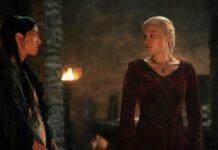Fans were so sure they had worked it all out. The big secret running through the entire Game of Thrones TV adaptation and original books was all about Jon Snow’s real identity. Clever readers pieced it together long before the show made the big reveal. Not only was Jon actually Aegon Targaryen, but he was also half of the Song of Ice and Fire with Daenerys. In fact, some even suggest he might fulfil both sides thanks to his Stark and Targaryen parents. Jon and Daenerys were always destined for each other, linked together by fate. Wrong. Daenerys’ fate was actually tied up with someone else together. Or, should that be some-thing?
It’s undeniable that Daenerys represents fire. She not only rides a fire-breathing dragon as part of her Targaryen heritage, but every part of her story is also highlighted with fire.
But it’s even more than that. Fire doesn’t just follow Daenerys wherever she goes, she literally is the fire made flesh. No other Targaryen was reported impervious to fire, yet Dany emerges from infernos unscathed time and again.
Fire marks every major moment from Khal Drogo’s pyre and the birth of the dragons to burning down the House of the Undying, the masters at Astapoor and the khals – all the way to King’s Landing. She has no victories without fire.
And who represents Ice made flesh? It really isn’t Jon, at all.
It is the Night King who is Dany’s equal and opposite. They were both brought into the world for one task which they both pursue with single-minded and terrifying focus. The fate of the world can not survive either of them. Time and again the HBO show mirrored scenes and motifs for the two of them.
Daenerys ignited the temple of the dosh khaleen and burned the khals alive, emerging wreathed in flames – the Night King arrived at Hardhome wreathed in ice and snow, and when he entered that hut every flame was extinguished.
Daenerys and the Night King riding their dragons spewing fire and ice are perfectly balanced. Both use the element at their command to execute their will and destroy their opponents. They mirror each other, two sides of the same whole.
When Dany can’t call on fire is when she has problems. She fails at Qarth because she doesn’t yet have the full fire-power. When she uses conventional armies and tactics on arriving in Westeros she is defeated and outmanoeuvred, although some blame must also go to Tyrion’s endlessly bad advice.
Daenerys is particularly ineffective at the Battle of Winterfell because her exact opposite has completely negated her power. Two dragons, however impressive, are dwarfed by the full power of winter.
The show even threw in repeating patterns, like the spiral of dead body parts made by the Others or the ecstatic celebratory spiralling circles made by the liberated slaves of Yunkai.
Daenerys’ command of fire is also why she has to die, not because she ‘went mad.’
Fire and ice both consume everything, no life or salvation can be possible while one is unchecked. Daenerys rises as the symbolic, elemental answer to the Night King and his armies. But then his defeat and death mean hers is not only inevitable – it is necessary.
Daenerys does not go mad, she is simply becoming the absolute embodiment of her element. She is not evil, no more than the Night King was evil. He was a vessel for his element and the original intentions of the Children of the Forest.
But Dany can not be allowed to live. Her intentions and actions aren’t just tainted by everything she has been through, they are dictated by her nature, which is forged in fire.
Only the Night King could balance her, without him she will burn down the world. A Song of Ice and Fire begins with them both and it must end with them both.



















![[Book Review] The Blade Itself (The First Law Trilogy) by Joe Abercrombie](https://bendthekneegot.com/wp-content/uploads/2018/01/1516047103_maxresdefault-218x150.jpg)

















